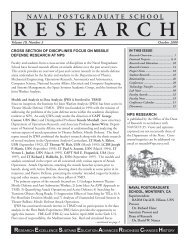Spectral Unmixing Applied to Desert Soils for the - Naval ...
Spectral Unmixing Applied to Desert Soils for the - Naval ...
Spectral Unmixing Applied to Desert Soils for the - Naval ...
You also want an ePaper? Increase the reach of your titles
YUMPU automatically turns print PDFs into web optimized ePapers that Google loves.
ut <strong>the</strong>re were a few that looked plausible. Endmembers 2, 3, and 32 (BSC 2, BSC 3,<br />
and BSC 1 in Figure 34, respectively) seemed <strong>the</strong> most likely candidates when inspected<br />
using <strong>the</strong> continuum removed method.<br />
Figure 34. This figure is <strong>the</strong> spectra <strong>for</strong> three imagery derived mean class endmembers<br />
thought <strong>to</strong> be BSCs and <strong>the</strong> spectrum <strong>for</strong> an endmember believed <strong>to</strong> be soil<br />
based on criteria established previously from Weber et al (2008) and <strong>the</strong><br />
results of <strong>the</strong> spectral libraries with <strong>the</strong> continuum removed function<br />
showing an absorption feature at ~650 nm not seen in soil (Figure 25).<br />
The endmembers chosen <strong>for</strong> BSC candidates showed shallower absorption<br />
features than vegetation endmembers that were slightly offset from <strong>the</strong> vegetation<br />
absorption feature near 650–700 nm. Endmember 14 is thought <strong>to</strong> be bare soil, though<br />
<strong>the</strong>re may be a BSC or vegetation component <strong>the</strong>re as well due <strong>to</strong> a slight absorption<br />
feature also around 700 nm; though it is much shallower and a different shape. Once <strong>the</strong><br />
endmembers were determined <strong>the</strong>y were scatter plotted as MF verses infeasibility <strong>to</strong> see<br />
how <strong>the</strong>y were distributed within <strong>the</strong> imagery and what MF scores would be associated<br />
with <strong>the</strong> most likely matches. The result of this can be seen in Figure 35 A and B.<br />
The collected endmembers from Mazourka Canyon were <strong>the</strong>n scatter plotted in<br />
<strong>the</strong> same image data set as <strong>the</strong> imagery derived ones and analyzed (Figure 35 C and D).<br />
67
















